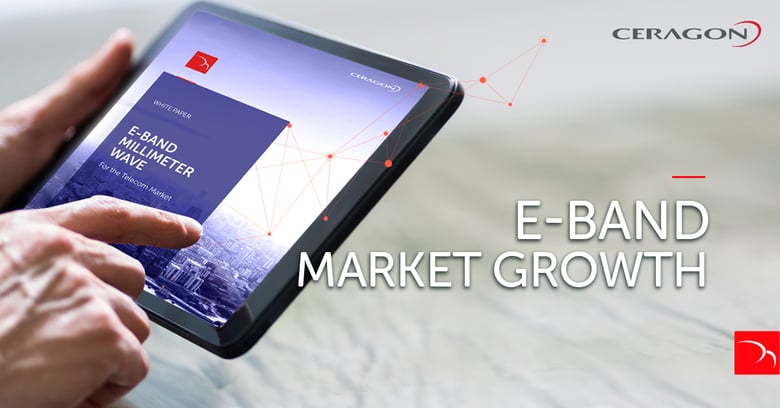The point-to-point (PtP) E-band millimeter wave (mmW) market has grown significantly in recent years. Based on industry analysts monitoring this market, E-band mmW grew some 20% annually in volume over the past several years, even before the widescale arrival of 5G.
Moreover, research firms assert that the mmW market will grow even more quickly over the next number of years as 5G deployments intensify. For example, the mmW technology market is expected to expand at a compound annual growth rate (CAGR) of 35% from 2020 to 2025 according to Mordor Intelligence*. Similarly, the telecom mmW technology market is expected to grow by a CAGR of 37% from 2020 to 2027 according to Grand View Research**, with E-band accounting for the vast majority of this market.
The main catalyst for E-band mmW growth is that network operators and service providers need to provide ultra-high capacity for 5G networks and services. Wireless backhaul systems over microwave and mmW transmission equipment will play a critical role in an operator’s successful 5G rollout for two simple reasons:
- Fiber is not available everywhere
- Time to market (TTM) is critical to success
Behind this operator need for ultra-high capacity lie several key drivers:
High-traffic use cases: The first driver is high-traffic use cases such as massive video streaming, immersive virtual reality (VR) and augmented reality (AR) environments, mega-scale Internet of Things (IoT) services for industrial firms, security, public safety services and more. Very low latency, which is supported by E-band, is essential for these kinds of applications.
Open network architectures: The second key driver is the move to open network architectures, and specifically Open RAN. In this move toward disaggregated networks, operators are implementing horizontal disaggregation by splitting up the central unit (CU), distributed unit (DU) and radio unit (RU), and then locating them separately or together in various combinations.
Dense urban deployments: mmW in general and E-band specifically are excellent for dense urban deployments, which require short distances and very high capacity. Many E-band links can be deployed in the same area to provide high capacity with low interference due to E-band’s utilization of very narrow antenna beams.
Industry 4.0: Building upon the Internet of Things (IoT), Industry 4.0 entails smart plants with connected machines and intelligent robots all communicating with each other over the same network. Flexibility is required to define and locate bandwidth dynamically, open bottlenecks, and analyze big data received from all connected components using artificial intelligence and machine learning to make sense out of this data. All this requires high-capacity links.
E-Band Alternatives
To understand the advantages of millimeter wave E-band for the above use cases, it’s useful to briefly compare E-band to its two main technological alternatives – fiber-optic cable and traditional microwave.
Fiber-optic cable
Fiber is often limited when it comes to “last mile” access connectivity. Indeed, in many cases fiber-to-the-x (FTTx) does not actually reach the desired end point (e.g. premises, buildings or homes) due to cost and implementation obstacles. Right-of-way issues related to digging trenches and laying fiber often make this option simply impossible to implement.
Traditional microwave
Traditional microwave suffers from limited and congested spectrum, especially in urban areas, and typical licensed spectrum channels are very narrow when compared to E-Band mmW. Due to limited available spectrum in these bands, lower channel bandwidth and wider antenna sizes, deployment of traditional microwave in dense urban or metropolitan areas is increasingly problematic.
E-Band Advantages
E-band mmW offers many technical and business advantages:
- High spectrum availability and ultra-high bandwidth (up to 20 Gbps) vs. traditional microwave
- Wide range of channel BW sizes, with channel separation ranging from 62.5 MHz to 2 GHz
- Very low latency performances (even lower than 20 microseconds) due to wide channels
- 99.999% (five-nine) availability at ranges of up to 1-2 km
- Small form factor and physical footprint
- Low spectrum fees vs. traditional microwave
- Minimization of interference due to utilization of very narrow antenna beams
- Reliable performance guaranteed under different weather conditions
- Rapid installation and return on investment (ROI) vs. buried fiber
- Low fixed costs and total cost of ownership (TCO) vs. buried fiber
Ceragon’s IP-50E Solution
In brief, the IP-50E is a cutting-edge E-band solution that delivers ultra-high capacity of up to 10 Gbps throughput in a single box. When two radios are deployed together in a cross-polarization interference cancellation (XPIC) configuration, the solution supports 20 Gbps over a single cable.
To learn more about E-band use cases and Ceragon’s IP-50E solution download the complete white paper
References:
*Millimeter Wave Technology Market – Growth, Trends, COVID-19 Impact, and Forecasts (2021-2026)


